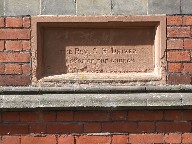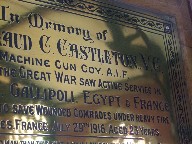| |
|
 |
|
Pakefield is a southern
suburb of Lowestoft,
and Lowestoft is home to Suffolk's
grandest Catholic church, Our
Lady, Star of the Sea.
However, like most Catholic churches in
Suffolk, Our Lady isn't really big enough
any more, so St Nicholas serves as its
chapel of ease south of the river. St
Nicholas was built by Baines and Baines
of London, the same architects as of Star
of the Sea. It was built at the same
time, and of the same materials, albeit
on a much humbler scale. What makes it
remarkable, however, is that St Nicholas
was not built as a Catholic church at
all. On May 8th, 1902,
just a month before Star of the Sea
opened for business, the foundation stone
was laid here for what was to be South
Cliff Congregational church. The
benefactor of the site was J. Colman of
Norwich, and the church opened in 1903.
The building consists of an Early
English-style nave in red brick with
white bandings, with large Perpendicular
windows. An octagonal turret sits on the
south-east corner, with a tall, tapering
tower and spirelet in the north-east
corner.
|
A
sanctuary bell-style fleche sits on the nave
roof, and small transepts accomodate a vestry and
an organ. There is a similarity with the
near-contemporary work in Suffolk of the
important architect Leonard Stokes, at Sudbury
for instance, particularly in its use of banding,
a corner tower and a fleche. A hall was added to
the west end of the building after the Second
World War, and in 1961 the South Cliff community
were one of the Congregational churches absorbed
into the new United Reformed Church, and this
church became Pakefield URC. Unfortunately, the
changing denominational climate meant that
numbers here rapidly fell, and eventually
Pakefield URC closed, the congregation moving in
with the one up the road at Kirkley. Clive
Brooks, in his excellent history of Lowestoft
parish published in the Diocese of East
Anglia Yearbook 2000, notes that the
building stood empty until 1995, when an approach
was made to the trustees by the Catholic Diocese
of East Anglia, keen to find a presence in the
south Lowestoft area.
I
was told by a nice old lady who I met in the
church that many of the former Congregationalists
were not at all happy about the building falling
into the hands of what she quaintly called
papists, but on August 11th, 1995, an emotional
ecumenical service was held in the newly
dedicated St Nicholas Catholic church. The
transition was marked by a 'Presentation of the
Gospels' ceremony, in which Reverend Donald
Clarke, the retired former minister of the URC
church handed a bible to the Catholic Priest,
Father Tony Sketch, signifying the continuance of
Christian teaching and worship in this place. The
congregation was made up of Catholics and
Congregationalists who had been members of the
former congregation here, and the ecumenical
Churches Together in Lowestoft was also
represented. A slate plaque on the east wall
commemorates the building's history, a marker of
the continuity of this sacred space across the
generations, and across the denominations, which
I thought was lovely.
You step into a cool, slightly dim
and predominantly red-brick interior, still
retaining much of the simplicity of its
Congregationalist days. The nice lady said that
she prefered it to Star of the Sea, and I could
see her point; here, the Art Nouveau style has
been paired down to its essence, and the
architecture is not distracting, merely
harmonious. The geometric acrobatics of the roof
are a contrast, the beams picked out in black on
white making them all the more dramatic.
| St Nicholas retains a
feature from the building's time as a
Congregational church which is of great
significance and importance. I had not
known about it, and I do not think that
many people will have. This is the plaque
which remembers Claud Charles Castleton,
who won Lowestoft's only Victoria Cross
of the First World War. Actually born an
Australian, he was the son of Thomas and
Edith Castleton of Wilson Road,
Lowestoft, and he was killed in the
Battle of the Somme on the 29th of July
1916. The Commonwealth
War Graves Commision website notes the
report in the London Gazette of 26th
September 1916: For
most conspicuous bravery. During an
attack on the enemy''s trenches the
infantry was temporarily driven back by
the intense machine gun fire opened by
the enemy. Many wounded were left in
"No Man''s Land" lying in shell
holes. Serjt. Castleton went out twice in
face of this intense fire and each time
brought in a wounded man on his back. He
went out a third time and was bringing in
another wounded man when he was himself
hit in the back and killed instantly.
|
|
 |
|
|
|

